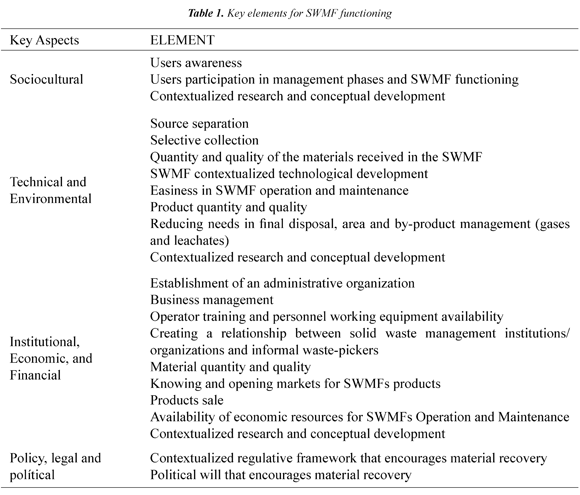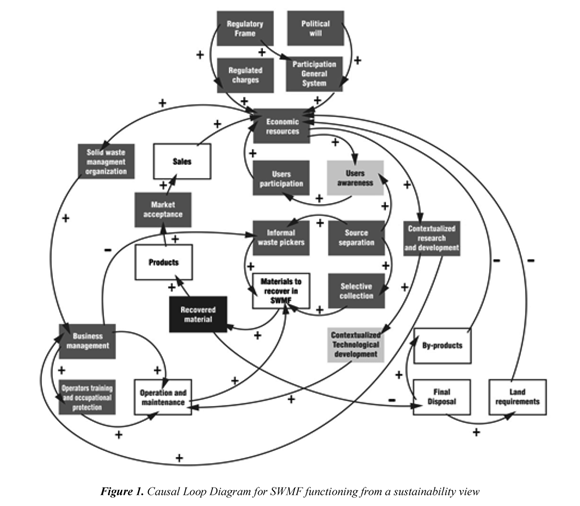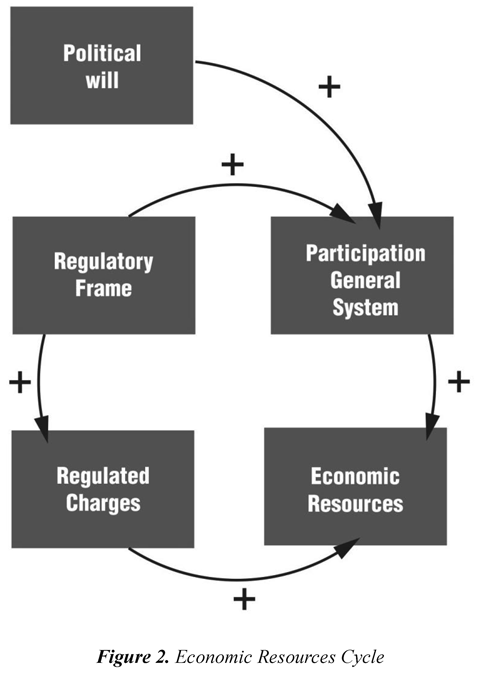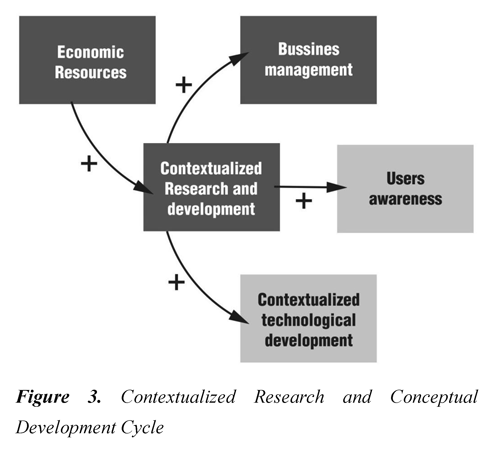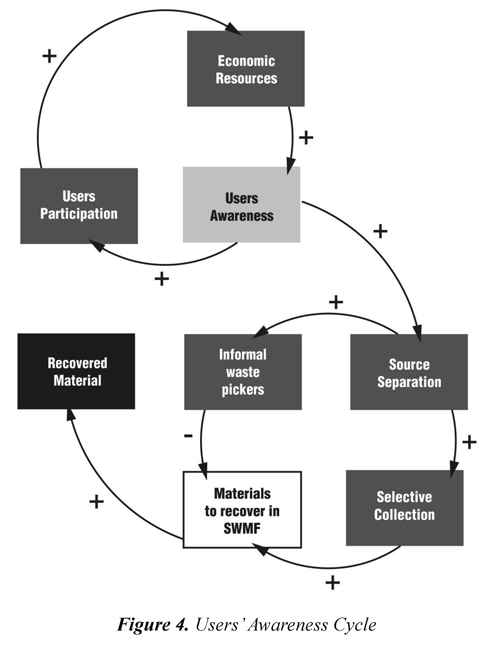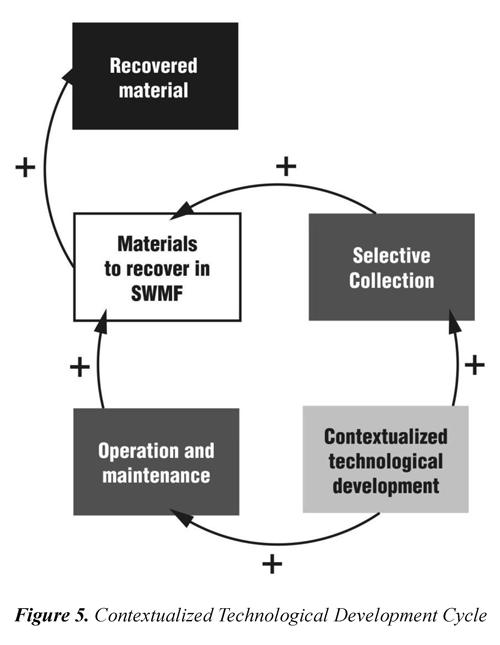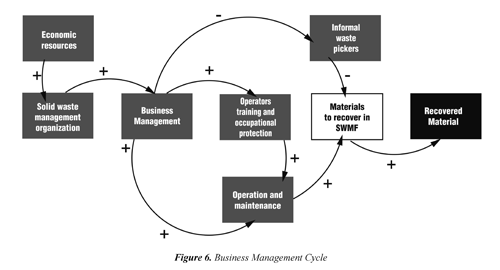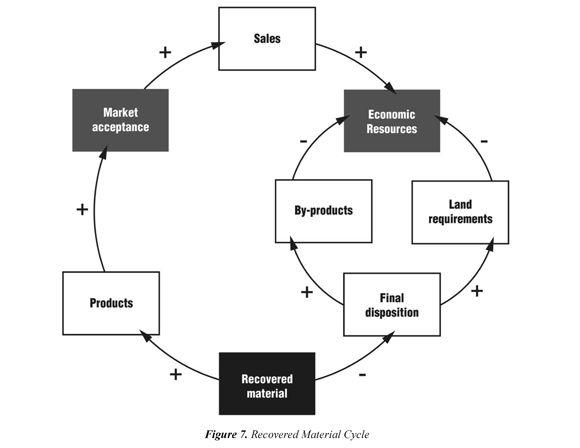Services on Demand
Journal
Article
Indicators
-
 Cited by SciELO
Cited by SciELO -
 Access statistics
Access statistics
Related links
-
 Cited by Google
Cited by Google -
 Similars in
SciELO
Similars in
SciELO -
 Similars in Google
Similars in Google
Share
Ingeniería y competitividad
Print version ISSN 0123-3033
Ing. compet. vol.15 no.2 Cali July/Dec. 2013
Systemic analysis of municipal solid waste management facility sustainability in municipalities with populations below 20,000 inhabitants
Análisis sistémico de la sostenibilidad de plantas de manejo de residuos sólidos municipales menores a 20.000 habitantes
Luis F. Marmolejo-Rebellón
Grupo de Investigación Estudio y Control de la Contaminación Ambiental, Facultad de Ingeniería, Universidad del Valle, Cali, Colombia
E-mail: luis.marmolejo@correounivalle.edu.co
Eje temático: Sanitary and environmental engineering / Ingeniería sanitaria y ambiental
Recibido: 22 de Abril de 2013
Aceptado: 24 de Agosto de 2013
Abstract
In Colombia, the National Policy of Integrated Waste Management recognizes waste utilization as the most desirable alternative for managing generated solid waste; in small municipalities' solid waste, its implementation has been taking place through Solid Waste Management Facilities-SWMFs. Studies carried out by governmental and academic institutions showed that although SWMFs generate environmental and social benefits, they present technological, economic, financial and institutional weaknesses, which put their sustainability in risk. In this paper, the Integrated Sustainable Waste Management approach is articulated with the System Dynamics Approach to consider and analyze the interrelationship among the key elements that influence SWMFs functioning and sustainability, based on information obtained through national dissemination events and assessments held in five SWMFs located northern Valle del Cauca. The systemic analysis led to identify six cycles or interrelationship groups. These were used to establish the bases for SWMFs sustainability, namely: economic resources, contextualized research and conceptual development, users' awareness, contextualized technological development business management and recovered material.
Keywords: causal loop diagram, integrated sustainable waste management, solid waste management, systems dynamics approach.
Resumen
En Colombia, la Política Nacional de Gestión de Residuos reconoce al aprovechamiento como la alternativa más deseable para el manejo de los residuos generados; en el caso de los residuos sólidos de pequeños municipios, su implementación se viene dando a través de Plantas de Manejo de Residuos Sólidos -PMRS. Estudios realizados por entidades gubernamentales y académicas, evidenciaron que aunque las PMRS generan beneficios ambientales y sociales, presentan debilidades tecnológicas, económicas, financieras e institucionales, que ponen en riesgo su sostenibilidad. En este documento se articula el enfoque de Gestión Integral y Sostenible de Residuos con el de Dinámica de Sistemas, para plantear y analizar las interrelaciones entre los elementos clave que influencian el funcionamiento y la sostenibilidad de las PMRS; para ello se tomó como referencia información obtenida a través de eventos de divulgación nacional y evaluaciones realizadas en cinco PMRS ubicadas en el Norte del Valle del Cauca. El análisis sistémico permitió identificar seis ciclos o grupos de interrelaciones, con los que se plantearon las bases para la sostenibilidad de las PMRS, a saber: Recursos Económicos, Investigación y Desarrollo Conceptual Contextualizados, Sensibilización de Usuarios, Desarrollo Tecnológico Contextualizado, Gestión Empresarial y material recuperado.
Keywords: Diagrama Causal, Gestión Integrada y Sostenible de Residuos, Gestión de Residuos, Análisis Sistémico.
1. Introduction
Recovering and recycling solid waste have been identified as key strategies for achieving the basic aims and fundamental requirements for sustainable development, contributing to reduce solid waste effects on environment and to increase resources profitability (United Nations, 2002). Following these postulates and the National Policy on Integrated Waste Management (Minambiente, 1998), municipalities with populations below 20,000 inhabitants in Colombia, which represent 88.2% of the total municipalities in the country (DANE, 2008), have been implementing Solid Waste Management Facilities -SWMFs. Their objective is to maximize recovery and to increase the value of the materials received in the facilities (SSPD, 2008); nevertheless, governmental institutions responsible for controlling them have deeply questioned the efficiency of these facilities (Procuraduria, 2003, SSPD, 2008), stating that "solid waste utilization and recycling facilities in Colombia are ecological and environmentally desirable, but not profitable" (SSPD, 2008b).
In northern Valle del Cauca Department, SWMFs began operating in Alcala, Bolivar, El Dovio, La Victoria and Versalles between 1997 and 2008, whose facilities are very similar to that defined by SSPD (2008) already constructed in the country. Studies carried out in these five SWMFs (SSPD, 2008; Marmolejo et al, 2010, 2011, 2012) have showed that they present technological, economic, financial and institutional weaknesses that put their sustainability in risk, and in turn, the municipal solid waste management system as a whole. In the matter, Van de Klundert & Anschütz (2001) propose the "Integrated Sustainable Waste Management" concept, which establishes that the solution to most problems related to solid waste management goes beyond money investment or equipment acquisition and that it is necessary to have an overall view of the situation to integrate the three main dimensions: i) stakeholders related to solid waste management, ii) elements that integrate a waste management system, and iii) local-context aspects conditioning the system functioning, seeking to reach technically appropriate solutions, economic and socially viable, without damaging environment. Authors like Diaz et al. (2007), Suttibak & Nitivattananon (2008), Troschinetz & Mihelcic (2009), Schoot Uiterkamp et al. (2011), Marmolejo et al. (2012b) and Zurbrügg et al. (2012) have specifically analyzed the system sustainability of material recovery from municipal solid waste in developing countries, showing the integral and sustainable management approach relevancy.
To approach SWMFs sustainability and to establish a relationship from the three dimensions proposed by Van de Klundert & Anschütz (2001), it is suitable to conceive recovery in SWMFs as a system and from this perspective, a sustainable SWMF can be defined as "a set of parts or elements interrelated for the efficient reincorporation of materials recovered from municipal solid waste to an economic and productive cycle, which is kept in time by means of technically appropriate strategies and economic and socially viable, without compromising environmental resources for future generations". In this context, and taking into account recovery benefits and its relevancy in national policies, this paper sets out and analyzes the interrelationship among the key elements that influence SWMFs functioning, providing an integral situation analysis, and criteria for achieving sustainability. An Integrated Sustainable Waste Management approach and a System Dynamics Approach were put together to achieve these aims; this approach articulation allowed to identify six interrelationship groups or sustainability-facilitating cycles.
2. Methodology
This research was developed in two stages: i) key element identification for SWMFs functioning and ii) the establishment of interrelationships among these elements, taking the Integrated Sustainable Waste Management (Van de Klundert & Anschütz, 2001), and the System Dynamics Approach guidelines as a principle.
2.1 Identifying key elements for SWMFs functioning
This stage was carried out in the doctoral research titled "Conceptual Framework for Material Recovery in Solid Waste Management Facilities located in municipalities with populations below 20,000 inhabitants in Northern Valle del Cauca - Colombia". The research was carried out in Alcala, Bolivar, El Dovio, La Victoria and Versalles. Taking into account that the studied SWMFs are similar to almost all other plants constructed in Colombia, these analyses can be taken as a reference for other municipalities with populations below 20,000 inhabitants in the country. The activities for obtaining the needed information are detailed below:
-Organizing a national forum called "Sustainability of Solid Waste Recovery in Colombia", held in Armenia in October, 2007, where experiences were presented, and issues on material recovery from municipal solid waste and its perspectives in Colombia were analyzed. In addition, a survey was applied to national and regional government body officers and to SWMFs operators. This survey was about experiences on recovery in SWMFs and the elements they believed to be fundamental for its sustainability in the country.
-Recognizing SWMFs functioning in municipalities located northern Valle del Cauca that included the technical, environmental, institutional, economic, legal, political and sociocultural aspects assessment by means of: i) reviewing documents and consultations to stakeholders related with the design, operation and maintenance of SWMFs; ii) following-up the solid waste management system in each municipality, emphasizing SWMF functioning; iii) assessing aspects related to the quantity and quality of received materials, the processes of conditioning or transforming these materials and the quantity and quality of products were made.
-Coordinating and accomplishing 11 Regional Meetings to discuss about SWMFs in Valle del Cauca held between 2007 and 2011. Their purposes were to have a feedback and to obtain a general view from key actors for facility functioning (operators, municipal officers and national and regional environmental authorities). Tools, such as brain storming (Robins & Coulter, 2005), SWOT analysis (Srivastava et al., 2004) and structural analysis (Castellanos et al., 2007) for identifying the key elements that affect SWMFs functioning were used.
Based on the results of previous activities, the information was consolidated managing to establish 19 key elements for SWMFs functioning; this result was socialized and validated by the participants in Regional Meetings, who shared this proposal. To facilitate the keyelements analysis and their interrelationship, the classification proposed by Van de Klundert and Anschütz (2001) for Integrated Sustainable Waste Management was selected, grouping them in the following key aspects: i) sociocultural, ii) technical and environmental, iii) economic, financial and institutional, and iv) policy, legal and political.
2.2 Establishment of the interrelationships among key elements
Considering that key elements are not independent and that their relationship is mandatory for SWMFs functioning and sustainability, the System Dynamics Approach tool known as causal loop diagram was used to establish the relationships. Its usefulness for simulating and analyzing complex systems, like solid waste management, has been recognized by some authors (Chaerul et al, 2008; Yuan et al., 2011; Yuan, 2012). A causal loop diagram includes elements and arrows called causal links, each arrow has an associated sign (+ or -). A causal linking between elements A and B is positive (+) when A reinforces B or a change in A goes in the same direction of B. The causal linking is negative (-) when A weakens B or when they go in an opposite direction.
3. Results and discussion
Table 1 presents the key elements identified for SWMFs functioning. The identified key elements are in coherence with those reported on the sustainability analysis of solid waste recovery options in developing countries stated by authors like Suttibak & Nitivattananon (2008), Troschinetz & Mihelcic (2009), Schoot Uiterkamp et al. (2011) and Zurbrügg et al. (2012); nevertheless, in this study, it is emphasized that contextualized research and conceptual development transcend technical and environmental aspects; besides, sociocultural, economic, financial, and institutional aspects are included. Marmolejo et al. (2010, 2011) present a description and analysis of the key elements identified.
Figure 1 presents the causal loop diagram showing the interrelationships among the key elements for SWMFs functioning from a sustainability view. The absence of any key element breaks the cycle that brings to obtaining recoverable materials in sufficient quantity and suitable quality in SWMFs; in turn, this affects transformation processes and product positioning in the market. As a result, recovery and valorization of most materials in SWMFs cannot be reached.
The construction, analysis and, discussion process of the causal loop diagram, besides facilitating systemic information interpretation, allowed the identification of six groups of interrelationships or key cycles generating sustainability conditions in SWMFs functioning. These key cycles were denominated in agreement with an agglutinative element. The agglutinative elements that emerged from this analysis were: i) Economic resources, ii) Contextualized research and conceptual development, iii) Users' awareness, iv) Contextualized technological development, v) Business management and vi) Recovered material. An analysis of each cycle is presented below:
3.1 Economic resources cycle
Having sufficient economic resources is a basic premise to guarantee the functioning of any productive unit as SWMF. In Colombia, solid waste management service is mainly supported with the users' charges, and also with economic resources granted from the Sistema General de Participaciones - Participation General System-PGS (Figure 2). Users' charges are established in the National Political Constitution (Presidencia, 1991) and in specific regulations of the Republic Congress (Congreso, 1994) and the Regulation Commission of Drinking Water and Basic Sanitation - CRA (2005). On the other hand, the participation of municipalities in the PGS is included in the National Political Constitution (Presidencia, 1991) and the 1176 Law, 2007 (Congreso, 2007).
In turn, the regulative frame is related to the political will of the national or local government, which is formally achieved with instruments, such as development plans and public policy documents. In the national regulatory frame, a Policy for Integrated Waste Management places recovery and valorization as a primary strategy for managing generated wastes (Minambiente, 2002). However, in documents as National Development Plans (DNP, 2007, 2011), a greater emphasis on the regional schemes of transfer and final disposition has been observed in the last two four-year presidential periods. Furthermore, in national regulations for Solid Waste Management, as the Act 1713, 2002 (Mindesarrollo, 2002), an obligation to analyze recovery viability is established only for municipalities with over 8,000 users; this can be interpreted as a discouraging fact for implementing material recovery from municipal solid waste in small municipalities. On the other hand, a political will is present, that although, it is not formally explicit in some cases, it keeps a relation with the priorities or political commitments established by governing bodies or leaders. This affects fundamental aspects such as stability of the government employees of solid waste management organizations and the continuity of local government policies.
3.2 Contextualized research and conceptual development cycle
As stated by Szirmai (2005), and cited by Schoot Uiterkamp et al. (2011), it is necessary to establish a national innovation system to link research and development (R&D) efforts to practical problems in context. In this study, it is defined as contextualized research and conceptual development. This statement becomes important because it is a key strategy in solid waste management element, such as recovery, which is a recently applied option in Colombia; its establishment was not supported by research experiences to provide the technological adjustment to local conditions (Marmolejo et al., 2011).
It is necessary to carry out research and conceptual development towards innovation, developing or adapting technologies to contexts, developing creative and effective awareness strategies in such a way that users' commitment can be encouraged and/or kept. In addition, it is basic to keep a continuous business management strengthening, and to adjust it to changeable market conditions, and to a changeable regulatory frame. As shown in Figure 3, research and development encouragement can positively change the three mentioned elements. Research and conceptual development require economic resources, which generally come from national government institutions related to science and technology, and recently the Fondo Nacional de Regalías (Congreso, 2012) has been an option to obtain these funds.
3.3 Users' awareness cycle
Figure 4 presents users' awareness cycle. In northern Valle del Cauca, continuity and diversity in awareness activities have showed to be basic elements to encourage users' participation, SWMFs recognition, and mainly to achieve the solid waste source separation. Users' participation is reflected in solid waste handling practices, payment of charges for solid waste management services, and finally their commitment to activities related to SWMFs (Marmolejo et al., 2010).
They represent resources that support facility functioning. Additionally, an encouraging element for users is to know the sanitary and environmental benefits of local recovery, as well as its impact on reducing waste collection, transport, and final disposal costs. This cost reduction should reduce users' charges. On the other hand, although source separation favors selective collection, and thus, the separation process in SWMF; in some instances, an increase of informal waste pickers was observed. They pick up recoverable materials before the collector vehicle did, making it necessary to establish conciliation measures among service operators, users and waste pickers.
3.4 Contextualized technological development cycle
Contextualized technological development simplifies the projection of technological options adapted to a local reality, and as shown in Figure 5, it affects other key elements, such as selective collection and SWMF operation and maintenance. For SWMFs, a technological development must include the conceptual and technological developments necessary i) to simplify the estimation of the quantities and characteristics of raw materials and products; ii) to optimize separating, transforming and conditioning processes; as well as iii) to develop a facility' information system adapted to local conditions.
Technology should be adapted to the local context, which in northern Valle del Cauca it is characterized by municipalities with a population below 20,000 inhabitants, farming activities, low income, elementary level education and high levels of unemployment. Optimizing a collection scheme and using technologies adapted to context will increase quality and quantity of the recovered material in SWMFs, which, in turn, will reduce solid waste final disposal requirements, and its by-product management.
3.5 Business management cycle
Legal recognition of solid waste management responsible organization has been a successful element for solid waste management. At the same time, this strengthens the managerial functions of solid waste management companies or organizations (administration, marketing, financing, operation and maintenance, planning and management, and information support) (MAVDT, 2005). As shown in Figure 6, this strengthening positively affects aspects such as operators' training and workers' equipment availability, SWMF operation and maintenance, and increases waste service incomes. In a similar way, using rule laws simplified by the legalization of solid waste management companies or organizations, has allowed to establish agreements among the waste-collecting company, informal waste pickers, and traders.
3.6 Recovered material cycle
As shown in Figure 7, the local and regional markets have the capacity to demand the products from SWMFs (Victoria et al., 2012), improving SWMFs profitability. As stated ahead, material recovery will reduce SMW's final disposal requirements, its subsequent need of a larger fill area, and gases and leachate treatment, which represents a decrease in the resources needed for final disposal (Norbu et al., 2005).
4. Conclusions
The combined application of an Integrated Sustainable Waste Management approach and the Systemic Dynamics Analysis showed that the synergy among stakeholders, that is, governing bodies, users, solid waste management service, and academic and research sectors, is basic for SWMFs sustainability. Governing bodies are in charge of formulating and applying the normative and legal frame that must support politically, administratively and financially SWMFs functioning. Raw material quantity and quality, and financial resources needed for its functioning have a high dependence on users' awareness. Solid waste management responsible organization is in charge of implementing a managerial scheme that besides optimizing service operations and maintenance, can establish cooperation agreements with users and with potential competitors as informal waste pickers; in addition, it can also project and position products in markets. Academic and research sectors are in charge of generating conceptual and technological developments adapted to context, and then, they must be translated to human talent qualification, who are in charge of designing, operating, maintaining and administrating SWMFs.
Under current circumstances, it is unlikely that SWMFs recovery can be a sustainable option in Colombia, due to the coexistence of aspects such as: the prioritization of final disposal established by means of national regulations laws, a low separation in source and selective collection of waste, the limited research and conceptual development on aspects related to SWMFs recovery, as well as the scarce personnel trained in this subject.
As shown in the drawn causal loop diagram, to achieve SWMFs sustainability, it is indispensable to intervene systematically on the key elements emphasized in this document because they generate benefits that respond to national and/ or specific needs of small municipalities, for example, sanitary and environmental-impact reduction associated to solid waste management, employment generation, cost reduction of collection, transport, and final disposal, and the consequent impact in user charges.
5. Aknowlegements
The author thanks Universidad del Valle for its support given to the development of his doctoral reserch project.
He is also grateful the directors, PhD engineers Patricia Torres and Luis Díaz; his advisors, professors Mariela García, Fred Albán, Rafael Klinger and Raúl Madriñan who wholeheartedly supported and supervised this project; as well as engineers Isabel Domínguez, Francisco Burbano, Luis Alfonso Hurtado and Ricardo Oviedo and all people who gave him their support and help.
6. References
Castellanos, O. (2007). Gestión Tecnológica: de un enfoque tradicional a la inteligencia . Bogotá, Colombia: Editorial Universidad Nacional de Colombia. [ Links ]
Chaerul, M., Tanaka, M., & Shekdar, A. V. (2008). A system dynamics approach for hospital waste management. Waste Management , 28 (2), 442-449. [ Links ]
Congreso - Congreso de la República. (1994). Ley 142 (11, julio, 1994). Por la cual se establece el régimen de los servicios públicos domiciliarios y se dictan otras disposiciones. Diario Oficial, Bogotá D.C., (41.433), 1-96. [ Links ]
Congreso de la República de Colombia (2007). Ley 1176 (27, Diciembre, 2007). Por la cual se desarrollan los artículos 356 y 357 de la constitución política y se dictan otras disposiciones. Diario Oficial. Bogotá D.C. , (46.854) 1-32. [ Links ]
Congreso de la República de Colombia (2012/09/19). Decreto 1949 (19 de septiembre, 2012). Por el cual se reglamenta parcialmente la Ley 1530 de 2012 en materia presupuestal y se dictan otras disposiciones. Diario Oficial , (48558). [ Links ]
CRA - Comisión de Regulación de Agua Potable y Saneamiento Básico (2005). Resolución 351 (20, diciembre, 2005) Por la cual se establecen los regímenes de regulación tarifaria a los que deben someterse las personas prestadoras del servicio público de aseo y la metodología que deben utilizar para el cálculo de las tarifas del servicio de aseo de residuos ordinarios y se dictan otras disposiciones . Bogotá D.C.: CRA. [ Links ]
Díaz, L. & Savage, G. (2007) Factors that affect the process. En. L. Díaz, M. de Bertoldi, W. Bidlingmaier & E. Stentiford. Compost science and technology . Oxford, UK: Elsevier. [ Links ]
DNP - Departamento Nacional de Planeación. (2007). Plan Nacional de Desarrollo 2006 - 2010. Estado Comunitario: desarrollo para todos (6, Junio, 2007) . Bogotá D.C., Colombia: DNP. [ Links ]
DNP - Departamento Nacional de Planeación. (2011). Bases del Plan Nacional de Desarrollo 2010 - 2014. Prosperidad para todos: Más empleo, menos pobreza y más seguridad (Sin publicación Oficial). Bogotá D.C., Colombia: DNP. [ Links ]
Marmolejo, L., Díaz, L., Torres, P. & García, M. (2012). Perspectives for sustainable resource recovery from municipal solid waste in development countries: Applications and alternatives. In, L. Marmolejo (Ed.) Waste Management - An Integrated Vision (cap. 7). Rijeka, Croatia: In Tech. [ Links ]
Marmolejo, L., Díaz, L., Torres, P., García, M., Burbano, M., Blanco, C., Erazo, K. & Pereira, J. (2010). Influence of Handling Practices on Material Recovery from Residential Solid Waste. Sustainability , 2, 2070-2083. [ Links ]
Marmolejo, L., Torres, P., Oviedo, E., García, M., & Díaz, L. (2011). Análisis del funcionamiento de plantas de manejo de residuos sólidos en el norte del Valle del Cauca, Colombia. Revista EIA , 16, 63-174. [ Links ]
Minambiente - Ministerio del Medio Ambiente. (1998). Política para la gestión integral de residuos . Bogotá D.C., Colombia: Minambiente. [ Links ]
Minambiente - Ministerio del Medio Ambiente. (2002). Selección de tecnologías de manejo integral de residuos sólidos. Bogotá D.C.: El Ministerio. 183MAVDT - Ministerio de Ambiente, Vivienda y Desarrollo Territorial). República de Colombia. (2005). Gestión empresarial. Municipios menores y zonas rurales . Bogotá D.C., Colombia: Minambiente. [ Links ]
Mindesarrollo - Ministerio de Desarrollo Económico. (2002). Decreto 1713 (6, agosto, 2002) Por el cual se reglamenta la Ley 142 de 1994, la Ley 632 de 2000 y la Ley 689 de 2001, en relación con la prestación del servicio público de aseo, y el Decreto 2811 de 1974 y la Ley 99 de 1993 en relación con la Gestión Integral de Residuos Sólidos . Bogotá D.C., Colombia: Mindesarrollo. [ Links ]
Presidencia de la República de Colombia (1991) Constitución Política . Santa Fé de Bogotá [ Links ].
Procuraduría - Procuraduría General de la Nación. (2003). Delegada para Asuntos Ambientales y Agrarios. Informe de Seguimiento. Gestión de los residuos sólidos en Colombia . Bogotá, Colombia: Procuraduría General de la Nación. [ Links ]
Robbins, S.P. & Coulter, M. (2005). Administración . México D.F.: Prentice Hall. [ Links ]
Schoot-uiterkamp, B., Azadi, H., & Ho, P. (2011). Sustainable recycling model: A comparative analysis between India and Tanzania. Resources, Conservation and Recycling , 55 (3), 344-355. [ Links ]
Srivastava, P., Kulshreshtha, K., Mohanty, C., Pushpangadan, P., & Singh, A. (2004). Stakeholder-based SWOT analysis for successful municipal solid waste management in Lucknow, India. Waste Management , 25 (5), 531-537. [ Links ]
SSPD - Superintendencia de Servicios Públicos Domiciliarios. (2008a). Diagnóstico sectorial plantas de aprovechamiento de residuos sólidos . Bogotá D.C., Colombia: SSPD. [ Links ]
SSPD - Superintendencia de Servicios Públicos Domiciliarios. (2008b). El reciclaje no reemplaza los rellenos sanitarios y las plantas de aprovechamiento no son rentables. Comunicado de prensa (17 de marzo de 2008) (p. 1). Bogotá D.C., Colombia: SSPD. [ Links ]
Suttibak, S. & Nitivattananon, V. (2008). Assessment of factors influencing the performance of solid waste recycling programs. Resources, Conservation and Recycling , 53, 45-56. [ Links ]
Troschinetz, A. & Mihelcic, J. (2009). Sustainable recycling of municipal solid waste in developing countries. Waste Management , 29, 915-923. [ Links ]
UNEP-Naciones Unidas. (2002). Programa 21, Cumbre Mundial sobre Desarrollo Sostenible Johannesburgo, 24 de agosto a 4 de septiembre de 2002 . Recovered 2013/12/15 http://www.cinu.org.mx/eventos/conferencias/johannesburgo/documentos/Agenda21/Programa21.htm [ Links ]
UNICEF - Fondo de las Naciones Unidas para la Infancia - COLOMBIA & Procuraduría - Procuraduría General de la Nación. (2006). La infancia, el agua y el saneamiento básico en los planes de desarrollo departamentales y municipales (p. 162). Bogotá, Colombia: UNICEF. [ Links ]
Van de klundert, A. & Anschütz, J. (2001). Integrated Sustainable Waste Management -the Concept. En, A. Scheinberg. Tools for Decision-makers. Experiences from the Urban Waste Expertise Programme (1995-2001) . Gouda, Netherlands: WASTE. [ Links ]
Victoria, F.A., Marmolejo, L. F., & Torres, P. (2012). Alternativas para fortalecer la valorización de materiales reciclables en plantas de manejo de residuos sólidos en pequeños municipios. Ciencia e Ingeniería Neogranadina , 22 (1), 59-73. [ Links ]
Yuan, H. (2012). A model for evaluating the social performance of construction waste management. Waste management , 32 (6), 1218-1228. [ Links ]
Yuan, H. P., Shen, L. Y., Hao, J. J., & Lu, W. S. (2011). A model for cost-benefit analysis of construction and demolition waste management throughout the waste chain. Resources, Conservation and Recycling , 55 (6), 604-612. [ Links ]
Zurbrügg, C., Gfrerer, M., Ashadi, H., Brenner, W., & Küper, D. (2012). Determinants of sustainability in solid waste management -The Gianyar Waste Recovery Project in Indonesia. Waste Management , 32 (11), 2126-2133. [ Links ]

Revista Ingeniería y Competitividad por Universidad del Valle se encuentra bajo una licencia Creative Commons Reconocimiento - Debe reconocer adecuadamente la autoría, proporcionar un enlace a la licencia e indicar si se han realizado cambios. Puede hacerlo de cualquier manera razonable, pero no de una manera que sugiera que tiene el apoyo del licenciador o lo recibe por el uso que hace.













